Southern Bluefin Tuna, Records, and Conservation in Tasmania and Beyond
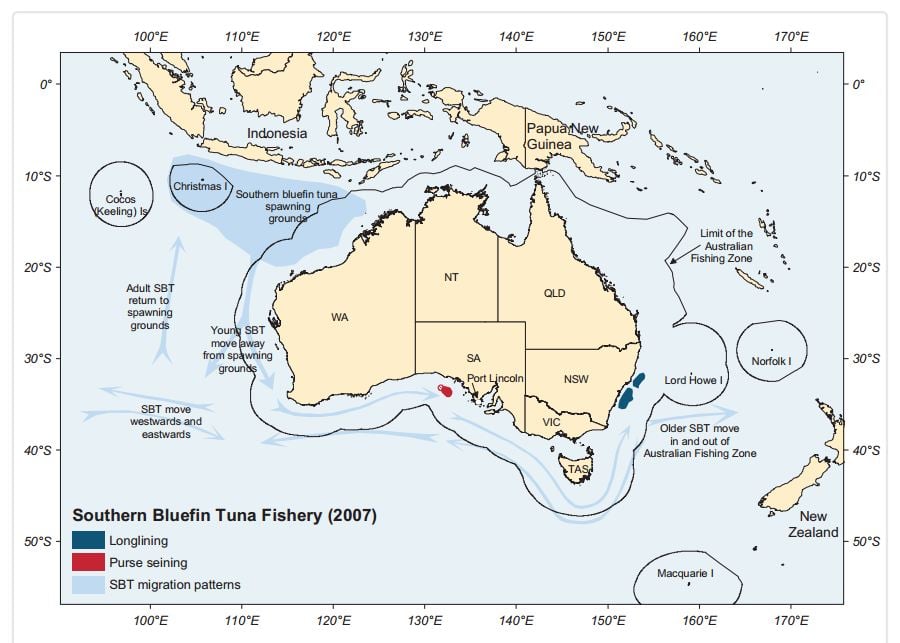
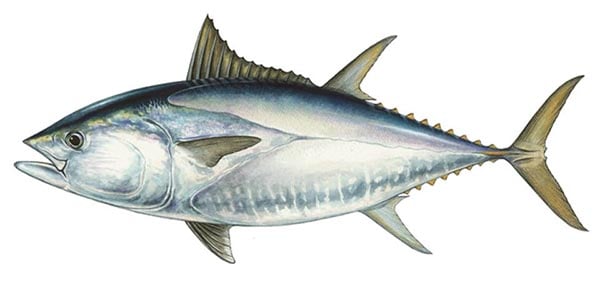 Southern bluefin tuna (Thunnus maccoyii) are among the ocean’s most powerful and wide-ranging predators. Found throughout the Southern Hemisphere—from the Atlantic to the Indian and Pacific oceans—this highly migratory species is built for endurance, speed, and strength. Reaching up to 7 feet in length with current IGFA All-Tackle World Record weighing 382-pound, 12-ounce (173.6 kilograms), these pelagic giants test even the most seasoned anglers and the toughest tackle.
Southern bluefin tuna (Thunnus maccoyii) are among the ocean’s most powerful and wide-ranging predators. Found throughout the Southern Hemisphere—from the Atlantic to the Indian and Pacific oceans—this highly migratory species is built for endurance, speed, and strength. Reaching up to 7 feet in length with current IGFA All-Tackle World Record weighing 382-pound, 12-ounce (173.6 kilograms), these pelagic giants test even the most seasoned anglers and the toughest tackle.
Though capable of traversing great distances, southern bluefin tuna have only one known spawning area: the northeastern Indian Ocean, south of Java. In waters around 75 degrees Fahrenheit, mature tuna gather between September and April to reproduce. Juvenile fish follow the Leeuwin Current southward along the Western Australian coast, spending their early years between the Great Australian Bight and the Tasman Sea until they reach maturity at around 5 years old. As they grow, they gradually shift into deeper waters and eventually join the transoceanic spawning migrations.
A Prize for Anglers Worldwide
Southern bluefin tuna are a prized species in recreational game fishing, and their pursuit for IGFA World Records offers not only an incredible challenge but also unforgettable moments for anglers. In southeastern Tasmania, the cold waters off Eaglehawk Neck have become one of the sport’s most iconic proving grounds.
In this video, Captain Stuart Nichols—no stranger to the IGFA record books, having guided his sons to world records in the past—ventures deep into Tasmania’s remote southeast coast with the team from Halco Tackle, an IGFA corporate member. They chase southern bluefin tuna in the unpredictable conditions off Eaglehawk with Halco Tackle King Brown Laser Pro 210 plugs, and despite the tough conditions, they made it happen!
Tasmania has a strong legacy in the IGFA record books, with 16 world records for southern bluefin tuna set in its waters over the years. The first came on June 10, 1978, when Stanley Gibbon landed a 220-pound, 7-ounce fish to claim the All-Tackle record at the time. Shanae Dance most recently added to this legacy when she set the IGFA Female Junior World Record with a 309-pound, 5-ounce (140-kilogram) catch on November 30, 2024. Her fight lasted over three hours and also stands as the Australian and Tasmanian record. The fish was caught on a Colorado lure in the Game Fishing Association of Australia’s National Junior Tournament—highlighting growing youth involvement in ethical, catch-conscious fishing.
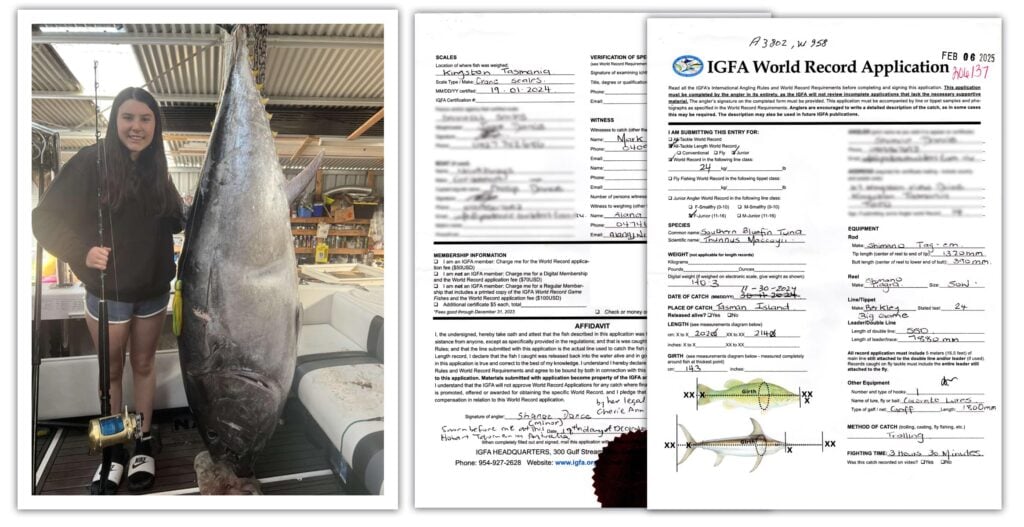
Beyond Tasmania, the current IGFA All-Tackle World Record is held by Charles Baty, who landed a 382-pound, 12-ounce (173.6 kilograms) southern bluefin tuna on Aug. 7, 2022, off White’s Island, New Zealand. That fish also set the men’s 80-pound line class record.
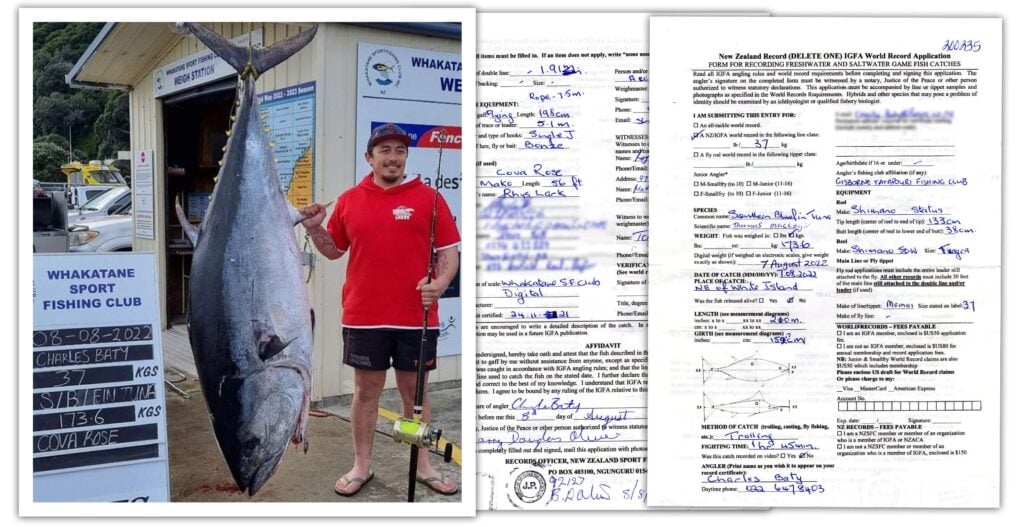
The largest southern bluefin tuna ever caught on fly under IGFA-compliant rules was landed by Craig Radford on June 27, 2012, off Narooma, New South Wales, Australia. The fish weighed 26.00 kilograms (57 pounds, 5 ounces), measured 117 centimeters (46.06 inches) in length, and had a girth of 79.6 centimeters (31.34 inches). Radford used a composite rod, Tibor reel, and Rio fly line with a 20-pound tippet, and hooked the tuna using a deceiver fly. The catch set the IGFA World Record for southern bluefin tuna on 20-pound tippet fly gear.

Managing The Fishery

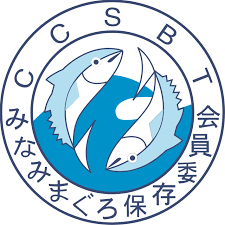
Despite their recent resilience, overfishing of southern bluefin tuna—primarily through pelagic longlines and purse seines—drove the population to dangerously low levels. Today, it is estimated that only 3% to 8% of the species’ original, unfished biomass remains.
In response, the Commission for the Conservation of Southern Bluefin Tuna (CCSBT)—an international body of eight member nations—has implemented strict catch quotas and rebuilding plans. Encouragingly, the most recent stock assessment in 2023 showed continued recovery, with projections indicating further gains under current management. The next assessment is scheduled for 2026.
To ensure recreational fishing remains part of the equation, the Australian Government commissioned a groundbreaking survey in 2019 to estimate recreational catch numbers. Conducted by the University of Tasmania’s Institute for Marine and Antarctic Studies (IMAS), this effort received widespread support and participation from recreational anglers in key regions such as South Australia, Victoria, New South Wales and Tasmania.
IGFA Trustee, Brett Cleary, and Chair of the Australian Recreational Fishing Foundation, praised the survey’s scientific rigor and its confirmation of the recreational fishery’s social and economic value. Cleary welcomed the Australian Government’s decision to allocate 5% of the national SBT quota to recreational fishers, ensuring no new restrictions on bag limits and preserving long-standing angling opportunities for generations to come.
The IGFA’s Role
The International Game Fish Association continues to play a central role in promoting the responsible and sustainable pursuit of southern bluefin tuna. Through our records program, we document historic catches, support junior angler participation, and set the ethical standard for recreational anglers worldwide. IGFA records don’t just celebrate angling achievements; they serve as a valuable historical archive and scientific resource.
We also collaborate with science and policy groups—like the CCSBT, and national foundations—to support education, research, and advocacy around sustainable fishing for southern bluefin tuna. With the southern bluefin tuna rebounding from the edge of collapse due to better fisheries management, the IGFA remains committed to ensuring that the species is not only protected but also appreciated.
